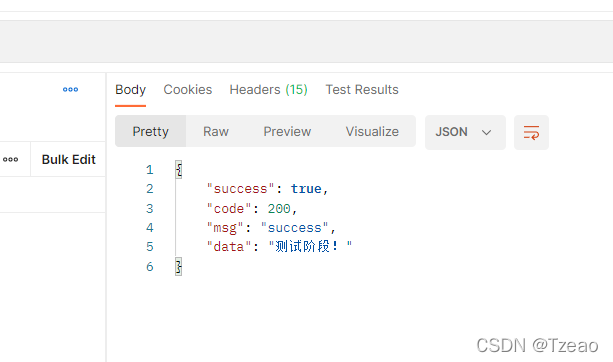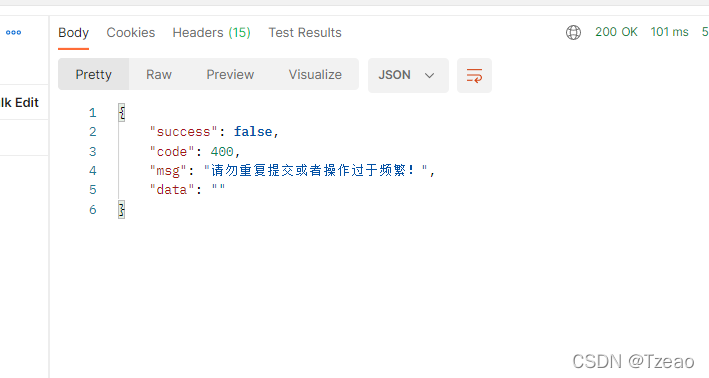java重复提交
Tzeao 人气:0在客户端网络慢或者服务器响应慢时,用户有时是会频繁刷新页面或重复提交表单的,这样是会给服务器造成不小的负担的,同时在添加数据时有可能造成不必要的麻烦。所以我们在后端也有必要进行防抖操作。
1.自定义注解
/**
* @author Tzeao
*/
@Target(ElementType.METHOD) // 作用到方法上
@Retention(RetentionPolicy.RUNTIME) // 运行时有效
public @interface NoRepeatSubmit {
//名称,如果不给就是要默认的
String name() default "name";
}2.使用AOP实现该注解
/**
* @author Tzeao
*/
@Aspect
@Component
@Slf4j
public class NoRepeatSubmitAop {
@Autowired
private RedisService redisService;
/**
* 切入点
*/
@Pointcut("@annotation(com.qwt.part_time_admin_api.common.validation.NoRepeatSubmit)")
public void pt() {
}
@Around("pt()")
public Object arround(ProceedingJoinPoint joinPoint) throws Throwable {
ServletRequestAttributes attributes = (ServletRequestAttributes) RequestContextHolder.getRequestAttributes();
assert attributes != null;
HttpServletRequest request = attributes.getRequest();
//这里是唯一标识 根据情况而定
String key = "1" + "-" + request.getServletPath();
// 如果缓存中有这个url视为重复提交
if (!redisService.haskey(key)) {
//通过,执行下一步
Object o = joinPoint.proceed();
//然后存入redis 并且设置15s倒计时
redisService.setCacheObject(key, 0, 15, TimeUnit.SECONDS);
//返回结果
return o;
} else {
return Result.fail(400, "请勿重复提交或者操作过于频繁!");
}
}
}
3.serice,也可以放在工具包里面,这里我们使用到了Redis来对key和标识码进行存储和倒计时,所以在使用时还需要连接一下Redis
package com.qwt.part_time_admin_api.service;
import org.springframework.beans.factory.annotation.Autowired;
import org.springframework.data.redis.core.*;
import org.springframework.stereotype.Component;
import java.util.*;
import java.util.concurrent.TimeUnit;
/**
* @author Tzeao
*/
@Component
public class RedisService {
@Autowired
public RedisTemplate redisTemplate;
/**
* 缓存基本的对象,Integer、String、实体类等
*
* @param key 缓存的键值
* @param value 缓存的值
* @return 缓存的对象
*/
public <T> ValueOperations<String, T> setCacheObject(String key, T value) {
ValueOperations<String, T> operation = redisTemplate.opsForValue();
operation.set(key, value);
return operation;
}
/**
* 缓存基本的对象,Integer、String、实体类等
*
* @param key 缓存的键值
* @param value 缓存的值
* @param timeout 时间
* @param timeUnit 时间颗粒度
* @return 缓存的对象
*/
public <T> ValueOperations<String, T> setCacheObject(String key, T value, Integer timeout, TimeUnit timeUnit) {
ValueOperations<String, T> operation = redisTemplate.opsForValue();
operation.set(key, value, timeout, timeUnit);
return operation;
}
/**
* 获得缓存的基本对象。
*
* @param key 缓存键值
* @return 缓存键值对应的数据
*/
public <T> T getCacheObject(String key) {
ValueOperations<String, T> operation = redisTemplate.opsForValue();
return operation.get(key);
}
/**
* 删除单个对象
*
* @param key
*/
public void deleteObject(String key) {
redisTemplate.delete(key);
}
/**
* 删除集合对象
*
* @param collection
*/
public void deleteObject(Collection collection) {
redisTemplate.delete(collection);
}
/**
* 缓存List数据
*
* @param key 缓存的键值
* @param dataList 待缓存的List数据
* @return 缓存的对象
*/
public <T> ListOperations<String, T> setCacheList(String key, List<T> dataList) {
ListOperations listOperation = redisTemplate.opsForList();
if (null != dataList) {
int size = dataList.size();
for (int i = 0; i < size; i++) {
listOperation.leftPush(key, dataList.get(i));
}
}
return listOperation;
}
/**
* 获得缓存的list对象
*
* @param key 缓存的键值
* @return 缓存键值对应的数据
*/
public <T> List<T> getCacheList(String key) {
List<T> dataList = new ArrayList<>();
ListOperations<String, T> listOperation = redisTemplate.opsForList();
Long size = listOperation.size(key);
for (int i = 0; i < size; i++) {
dataList.add(listOperation.index(key, i));
}
return dataList;
}
/**
* 缓存Set
*
* @param key 缓存键值
* @param dataSet 缓存的数据
* @return 缓存数据的对象
*/
public <T> BoundSetOperations<String, T> setCacheSet(String key, Set<T> dataSet) {
BoundSetOperations<String, T> setOperation = redisTemplate.boundSetOps(key);
Iterator<T> it = dataSet.iterator();
while (it.hasNext()) {
setOperation.add(it.next());
}
return setOperation;
}
/**
* 获得缓存的set
*
* @param key
* @return
*/
public <T> Set<T> getCacheSet(String key) {
Set<T> dataSet = new HashSet<>();
BoundSetOperations<String, T> operation = redisTemplate.boundSetOps(key);
dataSet = operation.members();
return dataSet;
}
/**
* 缓存Map
*
* @param key
* @param dataMap
* @return
*/
public <T> HashOperations<String, String, T> setCacheMap(String key, Map<String, T> dataMap) {
HashOperations hashOperations = redisTemplate.opsForHash();
if (null != dataMap) {
for (Map.Entry<String, T> entry : dataMap.entrySet()) {
hashOperations.put(key, entry.getKey(), entry.getValue());
}
}
return hashOperations;
}
/**
* 获得缓存的Map
*
* @param key
* @return
*/
public <T> Map<String, T> getCacheMap(String key) {
Map<String, T> map = redisTemplate.opsForHash().entries(key);
return map;
}
/**
* 获得缓存的基本对象列表
*
* @param pattern 字符串前缀
* @return 对象列表
*/
public Collection<String> keys(String pattern) {
return redisTemplate.keys(pattern);
}
/**
* @param key
* @return
*/
public boolean haskey(String key) {
return redisTemplate.hasKey(key);
}
public Long getExpire(String key) {
return redisTemplate.getExpire(key);
}
public <T> ValueOperations<String, T> setBillObject(String key, List<Map<String, Object>> value) {
ValueOperations<String, T> operation = redisTemplate.opsForValue();
operation.set(key, (T) value);
return operation;
}
/**
* 缓存list<Map<String, Object>>
*
* @param key 缓存的键值
* @param value 缓存的值
* @param timeout 时间
* @param timeUnit 时间颗粒度
* @return 缓存的对象
*/
public <T> ValueOperations<String, T> setBillObject(String key, List<Map<String, Object>> value, Integer timeout, TimeUnit timeUnit) {
ValueOperations<String, T> operation = redisTemplate.opsForValue();
operation.set(key, (T) value, timeout, timeUnit);
return operation;
}
/**
* 缓存Map
*
* @param key
* @param dataMap
* @return
*/
public <T> HashOperations<String, String, T> setCKdBillMap(String key, Map<String, T> dataMap) {
HashOperations hashOperations = redisTemplate.opsForHash();
if (null != dataMap) {
for (Map.Entry<String, T> entry : dataMap.entrySet()) {
hashOperations.put(key, entry.getKey(), entry.getValue());
}
}
return hashOperations;
}
}
4.测试
@NoRepeatSubmit(name = "test") // 也可以不给名字,这样就会走默认名字
@GetMapping("test")
public Result test() {
return Result.success("测试阶段!");
}

15秒内重复点击就会给提示

这样就完成了一个防止重复提交、频繁申请的程序
参考:
https://blog.csdn.net/chengmin123456789/article/details/107982095
加载全部内容